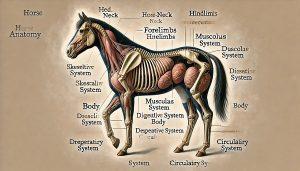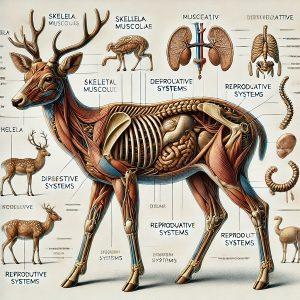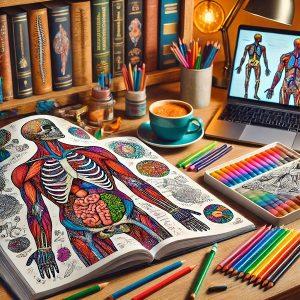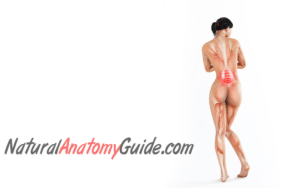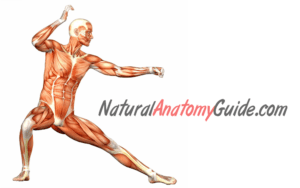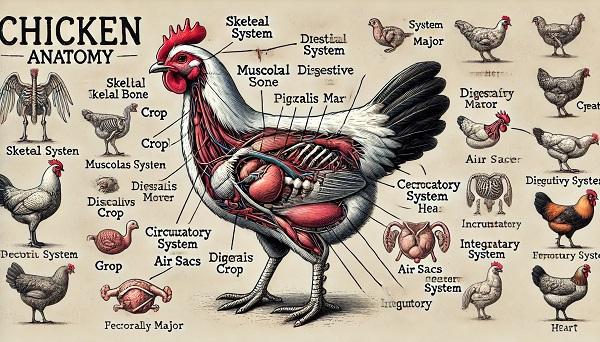

Introduction to The Anatomy of Chickens
The anatomy of chickens is a fascinating field that unveils the unique physical traits that enable chickens to adapt, thrive, and perform a range of behaviors essential to their survival. While domesticated chickens may seem ordinary, each part of their anatomy—from the lightweight skeletal structure adapted for flight to the complex digestive and respiratory systems—has evolved to support their active lifestyles. By understanding these key physical features, poultry keepers and enthusiasts alike can better meet their needs, improving health, comfort, and productivity. This guide explores seven essential aspects of chicken anatomy, shedding light on how each feature contributes to their overall well-being and functionality.
1- Skeletal Structure
The skeletal system of a chicken is designed for flight, even though domesticated chickens rarely take to the skies. This skeletal design is lightweight yet strong, providing critical support and protection for internal organs. Key components include the skull, vertebrae, limbs, and the prominent keel bone, also known as the sternum. The keel is an attachment point for powerful flight muscles, particularly beneficial in wild chickens and other birds capable of sustained flight. Not only does the skeleton provide physical stability, but it also contains hollow bones that reduce weight and assist in maintaining balance, particularly when roosting.
Related Amazon Product:
BoneUp Calcium Supplement
This calcium supplement is ideal for supporting strong, healthy bones, which is essential for maintaining the skeletal strength of laying hens.
2- Muscular System
Chickens possess a well-developed muscular system that allows them to move and perform a range of essential activities. The breast muscles, especially the pectoralis major, are significantly developed to aid in wing movement. Though domesticated chickens don’t rely on these muscles for extensive flight, they are still vital for short bursts of flight to avoid predators. Additionally, the leg muscles are robust, providing strength for scratching, perching, and walking. These muscles are also crucial for balance, allowing chickens to perform natural behaviors like dust bathing and foraging.
Related Amazon Product:
Roosting Perch
This roosting perch promotes natural perching behaviors, which help in strengthening and maintaining healthy leg muscles.
3- Digestive System
The digestive system of chickens is tailored to accommodate their omnivorous diet. It starts with the beak, an effective tool for picking up and breaking down food, although chickens do not have teeth. Once swallowed, the food moves down the esophagus and is stored temporarily in the crop, where it is softened. The stomach has two sections: the proventriculus (glandular stomach) and the gizzard (muscular stomach). The gizzard plays a crucial role in grinding food, assisted by small stones or grit that chickens naturally consume. Nutrients are absorbed in the intestines, and waste exits the body through the cloaca.
Related Amazon Products:
Grit for Chickens: A necessary addition for the gizzard to function effectively, ensuring proper digestion.
Feeding Station: This feeder manages and distributes food efficiently, minimizing waste and supporting consistent feeding routines.
4- Respiratory System
The respiratory system of chickens operates uniquely compared to mammals. Chickens have a set of lungs accompanied by multiple air sacs, allowing a continuous flow of air. This system is advantageous because it ensures that fresh air reaches the lungs on both inhalation and exhalation, providing a high oxygen exchange rate. This process enables chickens to maintain an active metabolism and assists in cooling, which is vital as chickens do not sweat.
Related Amazon Product:
Poultry VetRx Respiratory Relief
This product supports respiratory health, helping chickens manage common respiratory issues and maintain optimal breathing function.
5- Circulatory System
The circulatory system of chickens, like mammals, features a four-chambered heart that pumps blood throughout the body. However, a chicken’s heart rate is typically higher than that of mammals, essential for their active lifestyles and high metabolism. Chickens also have nucleated red blood cells, which differ from the anucleated red blood cells found in mammals. The circulatory system not only transports oxygen but also carries nutrients and removes waste products, ensuring the bird’s overall health.
Related Amazon Product:
Electrolyte Supplements
These supplements are helpful in maintaining hydration and circulatory health, especially beneficial in hot weather or when chickens are under stress.
6- Reproductive System
The reproductive anatomy in chickens varies significantly between hens and roosters. Hens possess a single functional ovary, usually the left one, which produces eggs. After ovulation, the egg travels through the oviduct, where albumen (egg white), membranes, and the shell form around the yolk. Roosters have two internal testes responsible for producing sperm. During mating, sperm is transferred to the hen, fertilizing the eggs. The reproductive system is highly efficient, allowing hens to lay eggs consistently once they reach maturity.
Related Amazon Product:
Nesting Boxes
Providing comfortable nesting boxes is crucial for hens’ reproductive health, ensuring a safe, stress-free environment for laying eggs.
7- Sensory Organs
Chickens rely heavily on their well-developed sensory organs. Their vision is particularly sharp, with a wide field and an ability to detect various colors, including ultraviolet light. Chickens have well-developed hearing, with ears located behind and slightly below the eyes, which are covered by feathers. These auditory senses are essential for detecting predators and communicating with flock members. Additionally, chickens’ beaks contain sensory receptors that aid in detecting textures and taste, which helps them identify edible food items.
Related Amazon Product:
Poultry Eye Gel
This product is designed to maintain healthy eyes, providing relief from potential irritations or infections that can impact a chicken’s vision and general well-being.
8- Integumentary System
The integumentary system in chickens consists of skin, feathers, combs, and wattles. Feathers provide insulation and protection, playing an essential role in temperature regulation and flight. Chickens also use their uropygial gland to secrete oil, which they spread over their feathers during preening, keeping them waterproof and flexible. The comb, wattles, and earlobes are prominent features involved in thermoregulation and serve as attractive traits during mating displays. These features also assist chickens in dissipating excess body heat, especially during hot weather.
Related Amazon Product:
Poultry Dust Bath
A dust bath supports natural grooming behaviors, which help chickens maintain healthy skin and feathers by removing parasites and excess oils.
Common Health Issues
Understanding chicken anatomy is fundamental for identifying and managing potential health issues. Respiratory infections, digestive disorders, and skeletal deformities are common in chickens and can often be mitigated with regular health checks and appropriate nutrition. Respiratory infections can be treated with medications, while digestive health often relies on proper grit and food management. Skeletal issues can stem from inadequate calcium levels, highlighting the importance of balanced nutrition. By addressing these potential health risks early, owners can ensure their chickens remain healthy and productive.
Conclusion
The intricate anatomy of chickens highlights the marvel of evolution, with each part finely tuned to support their unique needs and habits. From their specialized skeletal structure to their sharp sensory organs, chickens are built to thrive in diverse environments. Whether you’re raising chickens for eggs, companionship, or farm productivity, understanding their anatomy offers invaluable insight into their care and well-being. This knowledge can improve your flock management practices, making a significant difference in their health and quality of life.
Reference:
- “Anatomy of the Chicken and Domestic Birds” – Poultry Science, https://academic.oup.com
